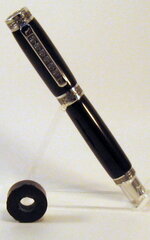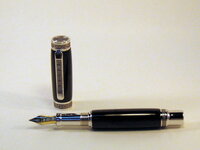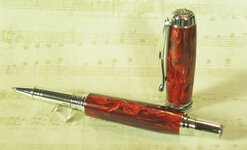ed4copies
Local Chapter Manager
Lately we have been receiving a few requests for further info on turning bakelite.
Here are MY observations:
First, Bakelite is about seventy years old - don't treat it like "turning acrylic" you bought from Taiwan.
To cut in half, I have had NO problems, so any saw should work. Be aware it is round, HOLD both halves firmly, so the blade does not grab and snatch the blank from you.
Drilling: THIS is where I have found some potential problems. I recommend drilling the blank vertically. To me, this means use the drill press. Set the drill, so it will stop short of exiting the blank. I drill about a quarter to a half an inch. Then, put cool water in the hole. Drill another half inch, dump the shavings AND the water and refill with cool water. Continue this strategy until you have reached the depth you set (again, you are not drilling THROUGH the blank)
IF you had enough that you can cut off the end and expose the hole, GREAT. IF not, hold the blank up to a light and mark the center of the hole, from the "plugged" side. Take a small drill bit and drill through the end, exposing your larger hole. Using a round file, make this small hole the same diameter as your "tube hole". The drilling is now complete.
OUNCE OF PREVENTION: Dry the inside of the hole, coat the inside with CA (thickness of your choice). This may help hold the material together, and it MAY require that you redrill or use the round file again.
HEAT IS BAD!!!! Do not do anything that creates a hot blank. IF you have used CA, let it sit a couple days, before moving on.
Glue in brass tubes - I use thick CA and let it sit 24 hours - you can do what you wish.
TURNING: They start out round, use a sharp skew (IMO) Take light cuts, even though there is a lot of material to remove. Did I mention these are SEVENTY YEARS old??? DON'T BEAT them. I believe this is causing much of the fracturing - which I have yet to experience.
HOWEVER, I DO stop from time to time. Patience is not my strong suit. I will usually only turn to about an eighth inch from finished on the first "sitting". Then, I finish the pen the next evening-first thing - while I am rested and sharp (as is my skew, I sharpen two before final turning).
SANDING: Remember the 100 grit gouge can be employed - no one sees what you are doing. HOWEVER, go slow so you don't generate heat.
FINISHING: Plastic polish, MicroMesh, for me-Bealle buffer (careful, this is a bad time to let go of the blank and have the buffer propel it across the room).
COMPONENTS: CLEAN your tubes, use that round file again to make them fit - epoxy the components in, if you must. But DON'T use a ton of pressure, this is SEVENTY YEAR OLD plastic, it WILL CRACK!!!
I have made several bakelite pens - almost all full size gents. I broke the first one, since then, they have all been completed. IF you have made pens from Bakelite and have any other "tricks" you would like to add, please do.
DISCLAIMER: Yes, Dawn buys and sells Bakelite. We CANNOT guarantee or warranty that product. It is expensive (relatively speaking). It MAY be fractured in the middle, when we purchase it. We have no way to know that. So, you are purchasing at your own risk.
THANK YOU!!! This thread looks like I am being defensive. This is NOT the case. So far, every communication I have received from unsuccessful attempts has been courteous and has blamed themselves for errors. I HATE SEEING PEOPLE UNSUCCESSFUL!!! This is supposed to be FUN!!!
So, those of you who HAVE made pens of bakelite, did I miss any good tricks???
Thanks for your help.
Here are MY observations:
First, Bakelite is about seventy years old - don't treat it like "turning acrylic" you bought from Taiwan.
To cut in half, I have had NO problems, so any saw should work. Be aware it is round, HOLD both halves firmly, so the blade does not grab and snatch the blank from you.
Drilling: THIS is where I have found some potential problems. I recommend drilling the blank vertically. To me, this means use the drill press. Set the drill, so it will stop short of exiting the blank. I drill about a quarter to a half an inch. Then, put cool water in the hole. Drill another half inch, dump the shavings AND the water and refill with cool water. Continue this strategy until you have reached the depth you set (again, you are not drilling THROUGH the blank)
IF you had enough that you can cut off the end and expose the hole, GREAT. IF not, hold the blank up to a light and mark the center of the hole, from the "plugged" side. Take a small drill bit and drill through the end, exposing your larger hole. Using a round file, make this small hole the same diameter as your "tube hole". The drilling is now complete.
OUNCE OF PREVENTION: Dry the inside of the hole, coat the inside with CA (thickness of your choice). This may help hold the material together, and it MAY require that you redrill or use the round file again.
HEAT IS BAD!!!! Do not do anything that creates a hot blank. IF you have used CA, let it sit a couple days, before moving on.
Glue in brass tubes - I use thick CA and let it sit 24 hours - you can do what you wish.
TURNING: They start out round, use a sharp skew (IMO) Take light cuts, even though there is a lot of material to remove. Did I mention these are SEVENTY YEARS old??? DON'T BEAT them. I believe this is causing much of the fracturing - which I have yet to experience.
HOWEVER, I DO stop from time to time. Patience is not my strong suit. I will usually only turn to about an eighth inch from finished on the first "sitting". Then, I finish the pen the next evening-first thing - while I am rested and sharp (as is my skew, I sharpen two before final turning).
SANDING: Remember the 100 grit gouge can be employed - no one sees what you are doing. HOWEVER, go slow so you don't generate heat.
FINISHING: Plastic polish, MicroMesh, for me-Bealle buffer (careful, this is a bad time to let go of the blank and have the buffer propel it across the room).
COMPONENTS: CLEAN your tubes, use that round file again to make them fit - epoxy the components in, if you must. But DON'T use a ton of pressure, this is SEVENTY YEAR OLD plastic, it WILL CRACK!!!
I have made several bakelite pens - almost all full size gents. I broke the first one, since then, they have all been completed. IF you have made pens from Bakelite and have any other "tricks" you would like to add, please do.
DISCLAIMER: Yes, Dawn buys and sells Bakelite. We CANNOT guarantee or warranty that product. It is expensive (relatively speaking). It MAY be fractured in the middle, when we purchase it. We have no way to know that. So, you are purchasing at your own risk.
THANK YOU!!! This thread looks like I am being defensive. This is NOT the case. So far, every communication I have received from unsuccessful attempts has been courteous and has blamed themselves for errors. I HATE SEEING PEOPLE UNSUCCESSFUL!!! This is supposed to be FUN!!!
So, those of you who HAVE made pens of bakelite, did I miss any good tricks???
Thanks for your help.



